May, 2020
Bellingham, WA
PNW
Spring is the time of nature’s regeneration and my yard is no exception. Six bird species have been active at some phase of the birthing process these past few weeks. The slowest are still nest building, others are well into the incubation process and will soon have gaping beaks sticking out of nests, begging for more food.
In past years I’ve had a couple of birds nesting in the yard but never six one time that I recall. Some Bucketters will recall last year that I documented Northern Flickers and Glaucous-winged Gulls from nest building to fledging. I’ll spare you that for these six and just give a quick survey of how my aviary yard is coming along.
Having been observing this nest building up close, I have come to further appreciate the various skills involved. Just acquiring the materials is no small feat as they collect twigs, branches, fur, feathers, moss, grass etc. Then, the weaving these various materials all together and some add mud to seal and secure the nest. And all this with no hands.
But there is more. The way those who nest in trees and bushes position their nests is also very finely tuned and camouflaged. They can be just a few feet away and still be virtually invisible due to their strategically placed nests. They know how to position the nest so that a leafed branch obscures direct observation from predators and nosey people wanting to take their picture. Hence, it is no easy task to get a reasonable photo of them at home while being careful not to invade their space and disrupt their life supporting tasks. Telephoto lenses help here but these wily architects still make one work for it. (Alas, the plans are often shown to be less than perfect.)
|
The Daily Bucket is a nature refuge. We amicably discuss animals, weather, climate, soil, plants, waters and note life’s patterns.
We invite you to note what you are seeing around you in your own part of the world, and to share your observations in the comments below.
|
Steller’s Jay (Cyanocitta stelleri ) seen in the lead photo.
This top crested member of the Corvid family can be real pests. They are squawkers who protect their nests aggressively yet are hunters of other birds nests and about anything that is edible. Being a corvid, they are also among the most intelligent birds.
Getting photos of this critter was no easy task, even though the nest is just about 5 feet from my living room window. As I noted above they can build nests such that they are nearly invisible and are camouflaged by strategically located branches. I took the lead photo by opening my window and holding the camera up so as to get above the branch and then extend my lens to get up close without intruding (and being careful not fall out the window). From all appearances, she did not seem to know that I was there. Typically the male sits on watch either on a nearby tree or roof top and scolds anyone who ventures on that side of the house.
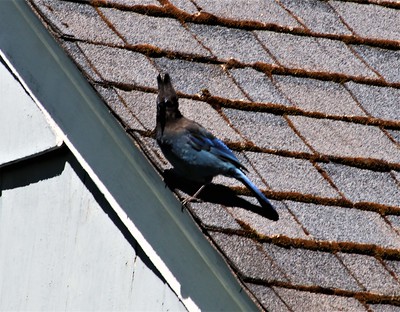 Papa Jay on the lookout for intruders from the rooftop.
Papa Jay on the lookout for intruders from the rooftop.
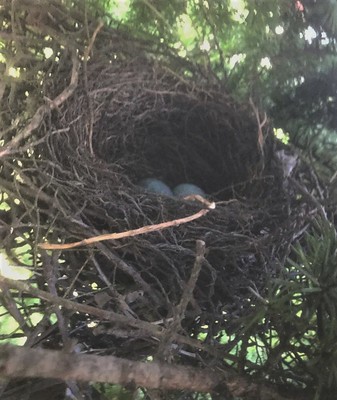
The photo of the eggs was even more difficult to get. For this one I had to wait until she left the nest which does she does every hour or so. Then I had to get a camera (used my iphone for this one) up high enough to see down inside the deep nest. So, I hung out the window and held the camera up over my head, blindly pointed down toward the nest. Fortunately I was able to capture the nest and eggs before she came back. Here there are two eggs visible and there might well be more lower in the nest. Typically Jays will lay 2 to 6 eggs.
But the party isn’t over yet. A couple of days after these photos, I was sitting in my living room where I could see the tree limb but not the nest directly. All of sudden I saw a great fuss with wings flapping lots of squawking. A crow had just bombed through the tree and into the nest, assumedly for the eggs. Since the Jay was sitting on them, they were not readily available for the taking. The crow took off with the jay right on its tail until it had left the yard. The jay went immediately back to the nest.
This appears to be a “bird eat bird” world this time of year.
American Robin (Turdus migratorius).
This Thrush is probably known by more people in north America than any other bird. Everyone knows and loves the robin as the harbinger of spring. My specimen was incubating her several baby blue eggs (I don’t know how many) in my laurel hedge near my barbecue on the patio. My canopy over the BBQ needs to be cleaned but I couldn’t do that without disturbing the robin. So, I get (got) a bit of a reprieve on that job.
This is Ms. American Robin as seen from a ladder at a distance with telephoto lens. Then tragedy struck.
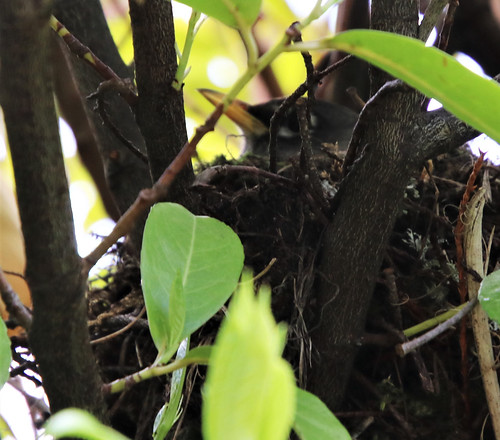 Momma Robin dutifully incubating her eggs
Momma Robin dutifully incubating her eggs
While I was writing this I went back outside to check on the robin and all looked well. Then after I came in the house, I saw what looked like a either a crow or a Steller’s Jay flying past the kitchen window with something in its beak. Had one of these corvids just lived up to its reputation and stolen the eggs from the robins? Was it the crow still looking for an easy lunch?
I went back out to see what was going on only to find both mom and pop Robins scolding a crow that was sitting on the edge of the roof nearby. The Robins were making a bit of a ruckus and began dive bombing the crow. The crow did not appear concerned with the attacks and eventually flew off.
On looking back at the nest now, I noted that it was disrupted with grass sticking up where as previously it had been very neat and tidy — as if there had been a visitor up to no good.
The robin took one more run through the nest but did not stay. She flew down the hedge a ways where she perched, picking and preening herself. I took a seat and observed her for about 20 minutes and she remained in the same spot.
 Momma Robin right after her brood was stolen
Momma Robin right after her brood was stolen
Checking later she had left and had not returned to the nest. I fear for the worst — that she lost her brood. I see that robins can have up to 3 broods per year but rarely do they all survive. Only about 40 % of the nests ultimately produce young.
Mother Nature can be harsh but she gives the robins more chances to maintain the species.
Spotted Towhee (Pipilo maculatus)
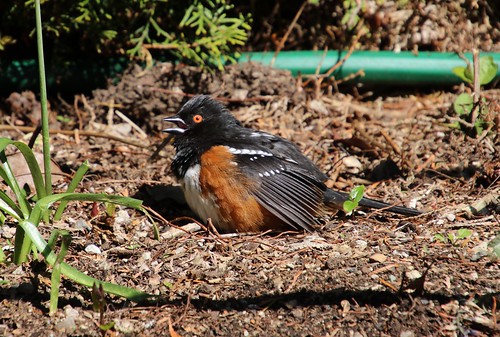 Spotted Towhee ready to lay her eggs.
Spotted Towhee ready to lay her eggs.
I don't have any exciting story to tell about the spotted Towhee as this is the only photo I have. I had observed the towhees around my garden and going into an arborvitae hedge that borders it. So, I was not surprised to see this female loaded with eggs at the base of the hedge. The hedge is way too dense for me to find her nest without totally disturbing her processes. We will have to imagine her nest and trust that she has built it in a secure spot as there are clearly nest robbers in the vicinity. Yesterday I spotted her (I think it is her) again in the same place but remarkably slimmer.
House Sparrow, (Passer domesticus)
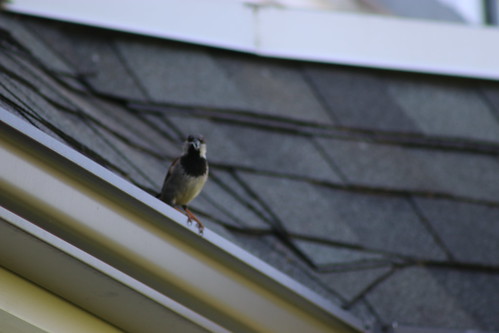 Here is a male House Sparrow sitting on the gutter with nest building material in his beek.
Here is a male House Sparrow sitting on the gutter with nest building material in his beek.
There is not much of a story here either as the house sparrow’s nest is down in our gutters and I don’t feel like climbing up there to see the nest. I do watch them come and go throughout the day, first when they were bringing in building supplies and now I imagine there are eggs to keep warm.
Northern Flicker (Colaptes auratus, red shafted)
 Female Flicker, great with eggs and displaying her rump with the white patch
Female Flicker, great with eggs and displaying her rump with the white patch
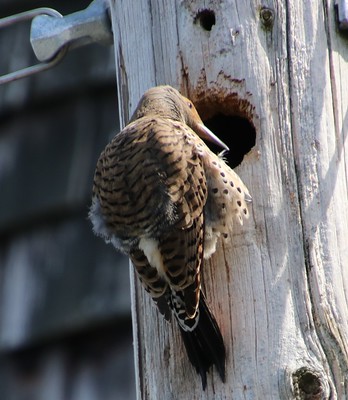 Here she iust fluffed up showing more light color underneath
Here she iust fluffed up showing more light color underneath
My fifth specie is a repeat of last year’s encounter with northern Flickers nesting in a utility pole. I don’t think this is the same pair, at least not the female shown in this photo. She is marked by a very distinctive white patch on her lower back. When she flares her feathers, it discloses even more white feathers underneath.
I believe they are now nesting too as they are repeating a trade off routine that I witnessed last year. One will stay on the eggs while the other forages. When the forager returns, to the nest, the other immediately flies out. They seem to be a very efficient tag-team.
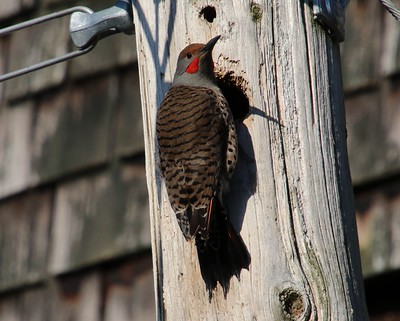 Male Flicker awaiting his turn on the nest
Male Flicker awaiting his turn on the nest
Glaucous-Winged Gull - (Larus glaucescens)
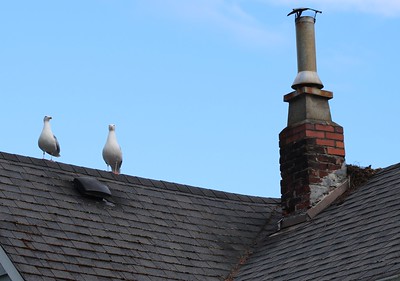 mom and pop during building at the right of the chimney
mom and pop during building at the right of the chimney
The last of my yard incubators are a pair of Glaucous-winged Gulls who are nesting against the chimney on my neighbor’s roof. The nest is in the same place as the one from last year but was built anew by this pair. As of this writing there are no eggs to incubate as they only spend a couple of hours in the early morning working on the nest and hanging out.
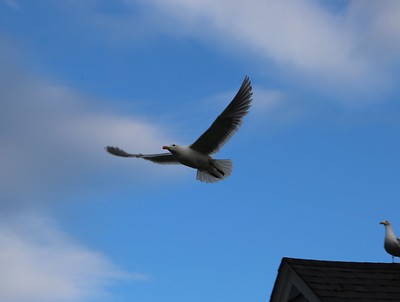 Off for more building materials
Off for more building materials
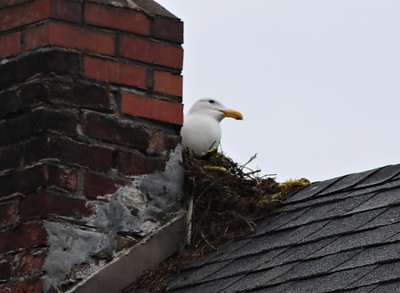 Finally on the nest for a several weeks sit. I am still not sure at this point if the eggs have been laid as she is only there occassionally.
Finally on the nest for a several weeks sit. I am still not sure at this point if the eggs have been laid as she is only there occassionally.
Addendum: These last two photos are not from my yard but I thought I would just add them as they are generally within the theme of reproducing birds. These were taken recently on my walks along the bay.
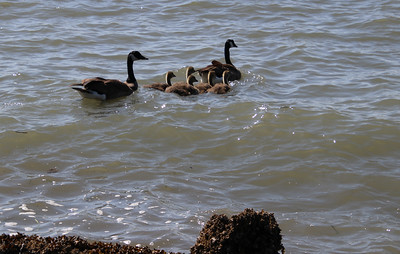 Canada goslings off for a paddle with mom and pop.
Canada goslings off for a paddle with mom and pop.
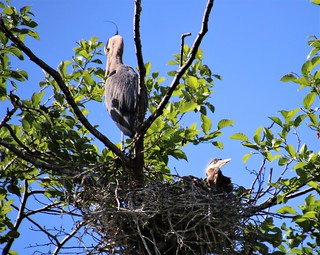 Great Blue Heron nest with two nearly developed youngsters. The fledge can’t be far away.
Great Blue Heron nest with two nearly developed youngsters. The fledge can’t be far away.
 SPOTLIGHT ON GREEN NEWS & VIEWS" IS POSTED EVERY SATURDAY AT 3:00 PM PACIFIC TIME ON THE DAILY KOS FRONT PAGE. IT'S A GREAT WAY TO CATCH UP ON DIARIES YOU MIGHT HAVE MISSED. BE SURE TO RECOMMEND AND COMMENT IN THE DIARY.
SPOTLIGHT ON GREEN NEWS & VIEWS" IS POSTED EVERY SATURDAY AT 3:00 PM PACIFIC TIME ON THE DAILY KOS FRONT PAGE. IT'S A GREAT WAY TO CATCH UP ON DIARIES YOU MIGHT HAVE MISSED. BE SURE TO RECOMMEND AND COMMENT IN THE DIARY.
Share with us the continuity of nature unfolding in your neighborhood.


